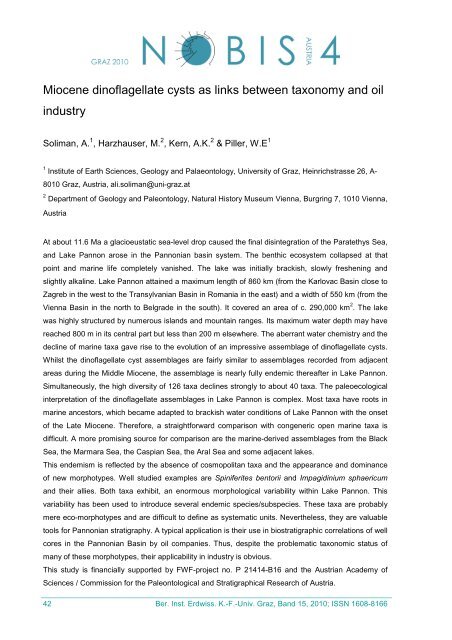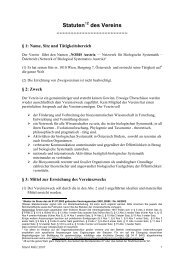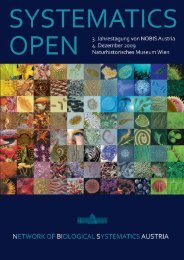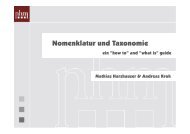4. Jahrestagung von NOBIS Austria 2. - 3. Dezember 2010
4. Jahrestagung von NOBIS Austria 2. - 3. Dezember 2010
4. Jahrestagung von NOBIS Austria 2. - 3. Dezember 2010
Create successful ePaper yourself
Turn your PDF publications into a flip-book with our unique Google optimized e-Paper software.
Miocene dinoflagellate cysts as links between taxonomy and oil<br />
industry<br />
Soliman, A. 1 , Harzhauser, M. 2 , Kern, A.K. 2 & Piller, W.E 1<br />
1 Institute of Earth Sciences, Geology and Palaeontology, University of Graz, Heinrichstrasse 26, A-<br />
8010 Graz, <strong>Austria</strong>, ali.soliman@uni-graz.at<br />
2 Department of Geology and Paleontology, Natural History Museum Vienna, Burgring 7, 1010 Vienna,<br />
<strong>Austria</strong><br />
At about 11.6 Ma a glacioeustatic sea-level drop caused the final disintegration of the Paratethys Sea,<br />
and Lake Pannon arose in the Pannonian basin system. The benthic ecosystem collapsed at that<br />
point and marine life completely vanished. The lake was initially brackish, slowly freshening and<br />
slightly alkaline. Lake Pannon attained a maximum length of 860 km (from the Karlovac Basin close to<br />
Zagreb in the west to the Transylvanian Basin in Romania in the east) and a width of 550 km (from the<br />
Vienna Basin in the north to Belgrade in the south). It covered an area of c. 290,000 km 2 . The lake<br />
was highly structured by numerous islands and mountain ranges. Its maximum water depth may have<br />
reached 800 m in its central part but less than 200 m elsewhere. The aberrant water chemistry and the<br />
decline of marine taxa gave rise to the evolution of an impressive assemblage of dinoflagellate cysts.<br />
Whilst the dinoflagellate cyst assemblages are fairly similar to assemblages recorded from adjacent<br />
areas during the Middle Miocene, the assemblage is nearly fully endemic thereafter in Lake Pannon.<br />
Simultaneously, the high diversity of 126 taxa declines strongly to about 40 taxa. The paleoecological<br />
interpretation of the dinoflagellate assemblages in Lake Pannon is complex. Most taxa have roots in<br />
marine ancestors, which became adapted to brackish water conditions of Lake Pannon with the onset<br />
of the Late Miocene. Therefore, a straightforward comparison with congeneric open marine taxa is<br />
difficult. A more promising source for comparison are the marine-derived assemblages from the Black<br />
Sea, the Marmara Sea, the Caspian Sea, the Aral Sea and some adjacent lakes.<br />
This endemism is reflected by the absence of cosmopolitan taxa and the appearance and dominance<br />
of new morphotypes. Well studied examples are Spiniferites bentorii and Impagidinium sphaericum<br />
and their allies. Both taxa exhibit, an enormous morphological variability within Lake Pannon. This<br />
variability has been used to introduce several endemic species/subspecies. These taxa are probably<br />
mere eco-morphotypes and are difficult to define as systematic units. Nevertheless, they are valuable<br />
tools for Pannonian stratigraphy. A typical application is their use in biostratigraphic correlations of well<br />
cores in the Pannonian Basin by oil companies. Thus, despite the problematic taxonomic status of<br />
many of these morphotypes, their applicability in industry is obvious.<br />
This study is financially supported by FWF-project no. P 21414-B16 and the <strong>Austria</strong>n Academy of<br />
Sciences / Commission for the Paleontological and Stratigraphical Research of <strong>Austria</strong>.<br />
_____________________________________________________________________________<br />
42 Ber. Inst. Erdwiss. K.-F.-Univ. Graz, Band 15, <strong>2010</strong>; ISSN 1608-8166






